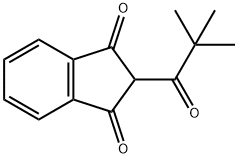Chemical Properties
Pindone is a bright yellow crystalline solid or powder. May turn yellow-brown on contact with air. Nearly odorless.
Uses
Insecticide; rodenticide
Uses
Pindone may be used as an analytical reference standard for the quantification of the analyte in biological samples using different chromatography techniques.
Definition
ChEBI: Pindone is a member of indanones and a beta-triketone.
General Description
Yellow solid or powder.
Air & Water Reactions
Insoluble in water.
Reactivity Profile
Ketones, such as PINDONE, are reactive with many acids and bases liberating heat and flammable gases (e.g., H2). The amount of heat may be sufficient to start a fire in the unreacted portion of the ketone. Ketones react with reducing agents such as hydrides, alkali metals, and nitrides to produce flammable gas (H2) and heat. Ketones are incompatible with isocyanates, aldehydes, cyanides, peroxides, and anhydrides. They react violently with aldehydes, HNO3, HNO3 + H2O2, and HClO4.
Health Hazard
Pindone is a vitamin K antagonist and causes inhibition of prothrombin formation, which results in hemorrhage.
There are no reports of effects in humans.
Fire Hazard
Flash point data for PINDONE are not available, but PINDONE is probably combustible.
Safety Profile
Poison by ingestion,
intravenous, and parenteral routes. Causes
reduced blood clotting, which leads to
hemorrhaging. Used as an anticoagulant and
rodenticide. When heated to decomposition
it emits acrid smoke and irritating fumes.
See also WARFARIN.
Potential Exposure
Pindone is used as an anticoagulant and rodenticide. A potential danger to those involved in manufacture, formulation and application of this chemical
Shipping
UN2811 Toxic solids, organic, n.o.s., Hazard Class: 6.1; Labels: 6.1-Poisonous materials, Technical Name Required. UN2588 Pesticides, solid, toxic, Hazard Class: 6.1; Labels: 6.1-Poisonous materials, Technical Name Required.
Incompatibilities
Ketone substances are incompatible with oxidizers (chlorates, nitrates, peroxides, permanganates, perchlorates, chlorine, bromine, fluorine, etc.); contact may cause fires or explosions. Keep away from alkaline materials, strong bases, strong acids, oxoacids, epoxides, nitrated amines; azo, diazo, azido compounds, carbamates, organic cyanates.
Waste Disposal
Use a licensed professional waste disposal service to dispose of this material. Dissolve or mix the material with a combustible solvent and burn in a chemical incinerator equipped with an afterburner and scrubber. All federal, state, and local environmental regulations must be observed. In accordance with 40CFR165, follow recommendations for the disposal of pesticides and pesticide containers. Must be disposed properly by following package label directions or by contacting your local or federal environmental control agency, or by contacting your regional EPA office.



